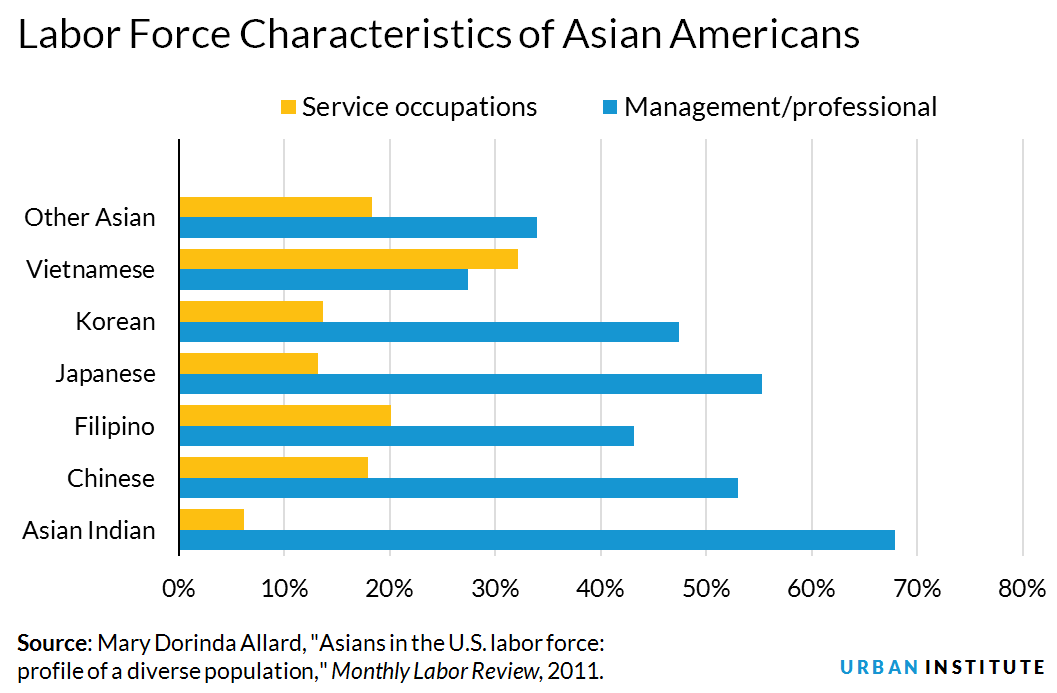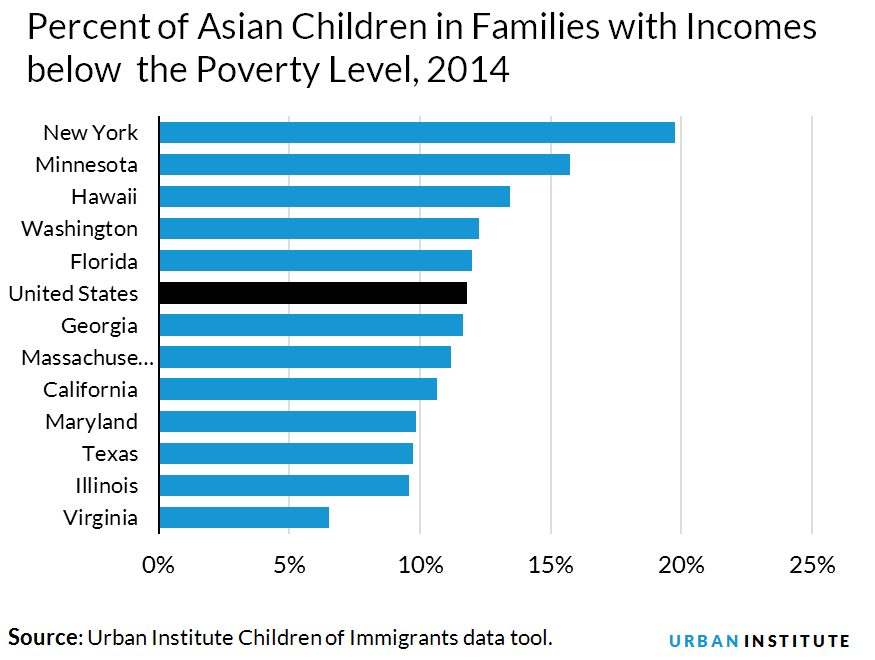
May is Asian Pacific American Heritage Month, a time to celebrate the collective identity and diversity of Asian Americans and Pacific Islanders (AAPI). Over the next month, Urban researchers explore data that shed light on challenges faced by distinct AAPI groups and how these groups strengthen their communities. Other posts in this series:
-
“Invisibility is an unnatural disaster”: Why funding the 2020 Census matters for Pacific Islanders
-
Many South Asians lack local resources to withstand rise in hate crimes
-
Asian Americans and Pacific Islanders, a missing minority in criminal justice data
-
Asian American seniors are often left out of the national conversation on poverty
-
Why don’t more eligible Asian Americans benefit from the earned income tax credit?
Asian Americans have been referred to as a “model minority” based, in part, on easily available statistics. The median education level of Asian Americans, for example, is higher than that of non–Asian Americans, and their average unemployment rates are lower. But these general measures mask large differences in the economic situation of Asians in the United States.
The variation within the Asian population is often overlooked because disaggregated data, or data that include information on individual countries of origin, is difficult to come by. When data are based on samples of the population, information on subgroups such as Asian Indian, Vietnamese, Korean, or Japanese might not be available. Fortunately, some studies allow us to look at frequently hidden differences in economic and social position within the Asian American community.
Labor market positions vary greatly among different Asian subgroups. For example, three-quarters of Asian Indians have at least a bachelor’s degree and over two-thirds are in management or professional jobs, but Vietnamese are less well positioned. One-fifth of Vietnamese Americans have less than a high school diploma, and similar numbers are in low-paying personal care and service jobs.

And while unemployment rates for all Asian groups are lower than rates for non-Asians, once they lose their jobs, Chinese and Filipino Americans are about 25 percent more likely to be unemployed for at least six months than other Asian and non-Asian groups.
The financial position of Asian Americans varies
On another measure of economic well-being, financial security and wealth, a recent report reveals significant disparity among Asian Americans in the Los Angeles area. Because the concentration of Asians in this area is higher than the national average, their economic position can provide insights into wealth variation across the different groups.
In comparison with a median net worth of $355,000 for white households in Los Angeles, three Asian subgroups—Japanese, Asian Indians, and Chinese—had higher median net worth, while three others—Filipinos , Vietnamese, and Koreans—had much lower net worth. That represents an enormous gap of 25 to 1 within the Asian community.

Asian American children also face diverse challenges
The economic position of Asian children varies substantially across the country. The Asian child poverty rate varies among states with a sizeable Asian population—rising above the national Asian child poverty rate of 12 percent in Minnesota and New York, for example, while falling below the national rate in Illinois and Virginia, according to the Urban Institute’s Children of Immigrants data tool.
Some of these differences are related to the different concentrations of Asian subgroups. In Minnesota, the poverty rate for children of Southeast Asian parents is 25 percent, compared with 4 percent for children of East Asian and the Pacific parents. Similar but smaller differences exist between these groups in other states.

Many Asian children do well in school, often despite economic and social adversity, but their childhoods are not always pleasant. A study looking at Asian American and Pacific Islander boys and young men in California reports that many found the school climate unwelcoming, and Southeast Asian and Pacific Islanders were routinely profiled by police and national security personnel.
Even the most successful Asian Americans have faced barriers to upward mobility in corporate America. A 2011 Leadership Education for Asian Pacifics (LEAP) study finds that Asians are far less likely to work their way up to CEO and board positions in private corporations. Although they were 6 percent of the population and 6.5 percent of the labor force in 2011, Asians held only 2.4 percent of the total board seats in Fortune 500 companies; only 18 Asian Pacific Americans held CEO positions. A more recent report shows only slow progress in recent years. While the number of Asians on Fortune 500 boards increased between 2012 and 2016 (from 2.1 to 3.1 percent), they are still one-half of their representation in the overall population.
While Asian Americans, on average, fare well on measures of education and employment, a closer look reveals great diversity by ethnicity, immigration status, and geographic area—as well as barriers to economic success. The “model minority” stereotype papers over these differences and hides the challenges many Asian Americans face.
Despite being the fastest-growing population in the United States, Asian Americans and Pacific Islanders (AAPI) are often overlooked or reported as a monolith in research on racial and ethnic disparities. Representation matters—and that’s especially true in policy research, where “invisibility is an unnatural disaster” (Mitsuye Yamada). Aggregate statistics obscure communities’ contributions and needs, so data disaggregated by ethnic origin are needed to change stereotypical narratives around AAPIs in every area of policy research.
Tune in and subscribe today.
The Urban Institute podcast, Evidence in Action, inspires changemakers to lead with evidence and act with equity. Cohosted by Urban President Sarah Rosen Wartell and Executive Vice President Kimberlyn Leary, every episode features in-depth discussions with experts and leaders on topics ranging from how to advance equity, to designing innovative solutions that achieve community impact, to what it means to practice evidence-based leadership.